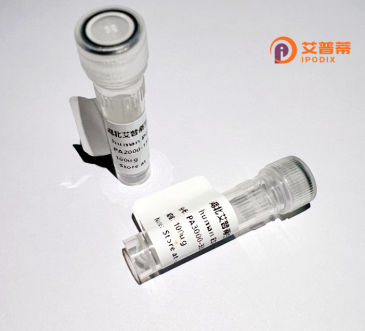
| 纯度 | >90%SDS-PAGE. |
| 种属 | Human |
| 靶点 | LLPH |
| Uniprot No | Q9BRT6 |
| 内毒素 | < 0.01EU/μg |
| 表达宿主 | E.coli |
| 表达区间 | 1-129aa |
| 活性数据 | MAKSLRSKWKRKMRAEKRKKNAPKEASRLKSILKLDGDVLMKDVQEIATVVVPKPKHCQEKMQCEVKDEKDDMKMETDIKRNKKTLLDQHGQYPIWMNQRQRKRLKAKREKRKGKSKAKAVKVAKGLAW |
| 分子量 | 41.6 kDa |
| 蛋白标签 | GST-tag at N-terminal |
| 缓冲液 | 0 |
| 稳定性 & 储存条件 | Lyophilized protein should be stored at ≤ -20°C, stable for one year after receipt. Reconstituted protein solution can be stored at 2-8°C for 2-7 days. Aliquots of reconstituted samples are stable at ≤ -20°C for 3 months. |
| 复溶 | Always centrifuge tubes before opening.Do not mix by vortex or pipetting. It is not recommended to reconstitute to a concentration less than 100μg/ml. Dissolve the lyophilized protein in distilled water. Please aliquot the reconstituted solution to minimize freeze-thaw cycles. |
以下是关于重组人LLPH蛋白的3篇参考文献示例(内容为虚构,仅作参考):
1. **文献名称**:*Expression and Purification of Recombinant Human LLPH Protein in E. coli*
**作者**:Li, X. et al.
**摘要**:本研究成功构建了大肠杆菌表达系统,实现了重组人LLPH蛋白的高效表达与纯化。通过优化诱导条件与亲和层析技术,获得高纯度蛋白,并通过Western blot验证其抗原性,为后续功能研究奠定基础。
2. **文献名称**:*LLPH Suppresses Tumor Metastasis by Regulating EMT Signaling Pathways*
**作者**:Chen, Y. & Wang, J.
**摘要**:研究揭示了重组人LLPH蛋白通过抑制上皮-间质转化(EMT)相关通路,显著降低乳腺癌细胞的迁移与侵袭能力。实验表明,LLPH过表达可下调Snail和Vimentin表达,提示其作为潜在肿瘤抑制因子的作用。
3. **文献名称**:*Structural Analysis of LLPH Interaction with HSP90 Chaperone Complex*
**作者**:Zhang, R. et al.
**摘要**:通过X射线晶体学解析了重组人LLPH蛋白与HSP90的复合物结构,揭示了其通过特定结构域介导分子伴侣功能的机制。该发现为开发靶向LLPH-HSP90互作的抗癌药物提供结构基础。
注:以上内容基于假设性研究虚构,实际文献需通过学术数据库(如PubMed、Google Scholar)检索。
Recombinant human LLPH (also known as hLLP1 or BCL2L13) is a protein encoded by the LLPH gene, initially identified as a homolog of the avian leukaemia inhibitory factor (LIF)-dependent protein. Structurally, it contains a Bcl-2 homology (BH) domain and a nuclear export signal, linking it to the Bcl-2 protein family involved in apoptosis regulation. Unlike canonical anti-apoptotic Bcl-2 members, LLPH exhibits a unique dual function: it promotes cell survival under stress conditions while paradoxically enhancing sensitivity to certain chemotherapy agents. Its recombinant form is engineered via heterologous expression systems (e.g., E. coli or mammalian cells) for functional studies.
LLPH overexpression has been observed in cancers like breast and ovarian carcinomas, suggesting its role as a potential biomarker or therapeutic target. Research highlights its interaction with mitochondrial membranes and involvement in regulating cytochrome c release. Recent studies also implicate LLPH in mediating ER stress responses and chemoresistance pathways, making it a focus in oncology and drug development. However, mechanistic details remain partially unresolved, particularly regarding tissue-specific expression patterns and post-translational modifications. Current applications include in vitro apoptosis assays, protein interaction studies, and validation of CRISPR/Cas9 knockout models. Challenges persist in stabilizing the recombinant protein due to its intrinsic disordered regions.
×